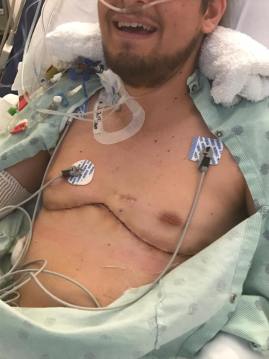Strong in the Broken Places: My CF Scars
Written by |

My arms were scarred and barren of muscle, thin as twigs. They hung from a bumpy, pale torso — bumpy from the ribs that protruded, the port-a-cath that sat beneath pockmarked skin, and the rubber feeding tube above my belly button. Below my torso: thighs striped with purple skin due to extreme doses of steroids. Above: thin, brittle hair and stained teeth, victim to caustic medication.
These imperfections were physical evidence of cystic fibrosis and I hated them for that. Despite living in warm Hawaii, I almost always covered up with a jacket and jeans to hide my skinny limbs. I refused to go shirtless at the beach, hunched my shoulders forward to make the port stick out less, and sucked my stomach in so the feeding tube couldn’t be seen through my shirt. I’d rarely be seen without a hat to cover my brittle hair. Most of my friends knew I had cystic fibrosis but I always tried to hide how severe it was. I felt weak and ugly.
The evidence of my cystic fibrosis is still there today, nine months post-lung transplant, with slight changes. My ribs poke out a little less and I have muscles on my body (they’re small, but they’re there). My chest now has a sunken, bruised-looking area under a couple 2-inch scars, reminders of the nearly fatal Candida infection I had in my port last year and the subsequent removal of the catheter. I also have two 3-inch scars behind my ears where cochlear implants were placed to repair my deafness caused by amikacin. The biggest of “slight changes” is a gigantic scar stretching the breadth of my chest and round, silver dollar-sized scars — two on each side of my rib cage. Evidently, removing and inserting lungs and chest tubes requires some cutting here and there.
With the collection of more and more scars, my perspective on what they mean has shifted. I’ve begun to think of these marks as symbols — evidence of strength rather than weakness. The scars and imperfections are reminders of endurance and battles I probably shouldn’t have survived. Even at times I mentally surrendered, my body kept struggling through — matter over mind, for once.
A couple years ago, I was in the dumps about how broken my body was. I had lost all my hearing and my lungs were steadily shutting down. Someone anonymously left a blue ceramic bowl on my desk at work to cheer me up. The bowl was “broken,” but gold filled the cracks through Kintsugi (“golden joinery”).
Kintsugi is a Japanese art: Broken pottery is repaired with gold, silver, or platinum. With these careful fixes, the pottery is even more beautiful than when it was whole. I didn’t know it then, but I was about to undergo the same treatment as the pottery, via lung transplant. However, the cracks across my broken chest are filled with purple-pink scar tissue rather than gold.
I’ve found beauty in that symbolism, and in my body as a result. I still have a long way to go in repairing things and building muscle. But my body has taken me far, far, far, and proven that it’s not as weak as I previously judged it to be. I’m confident it will take me even farther.
“The world breaks everyone and afterward many are strong in the broken places.”
—Hemingway
***
Note: Cystic Fibrosis News Today is strictly a news and information website about the disease. It does not provide medical advice, diagnosis, or treatment. This content is not intended to be a substitute for professional medical advice, diagnosis, or treatment. Always seek the advice of your physician or other qualified health provider with any questions you may have regarding a medical condition. Never disregard professional medical advice or delay in seeking it because of something you have read on this website. The opinions expressed in this column are not those of Cystic Fibrosis News Today, or its parent company, Bionews Services, and are intended to spark discussion about issues pertaining to cystic fibrosis.










Lise Hunter
What an awesome story of personal strength and resilience...you are admirable...fight on!!